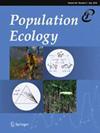鹿引起的森林退化对河流生态系统动态的区域效应
IF 1
4区 环境科学与生态学
Q4 ECOLOGY
引用次数: 0
摘要
几乎所有生态系统都是开放系统,这意味着一个生态系统的重大变化会导致其他生态系统发生意想不到的变化。鹿的过度繁殖已成为一个全球性问题,导致森林退化,不仅影响陆地生态系统,也影响水生生态系统。本研究旨在通过考察鹿引起的森林退化对鱼类种群的影响,研究大型食草动物在生态系统间相互作用中的区域尺度重要性。我们从日本兵库县的河流系统中选择了类似规模的集水区,这些集水区在鹿引起的森林退化后的时间上有所不同。我们在 23 个集水区进行了鱼类密度和微生境环境的常规调查,并在 95 个集水区进行了定量 eDNA 代谢编码调查。考虑到混杂效应,我们研究了鱼类种群密度、微生境和森林退化时间之间的关系。通过浮潜和 eDNA 方法分别检测到的 8 种和 17 种鱼类分类群的数据可用于统计分析。浮潜计数(个体/1 米横断面)与河水中的 eDNA 浓度(拷贝数/升)密切相关。河床上的细小沉积物在森林退化后的 3-15 年间有所增加,16 年后有所减少。根据 eDNA 和浮潜推断,喜沙鱼类的种群密度也合理地遵循了这一规律。这些模式可能是山坡上细小沉积物枯竭造成的。这项研究的结果表明,鹿引起的世界范围内的交替也可能发生在水生生态系统中。本文章由计算机程序翻译,如有差异,请以英文原文为准。
Regional‐scale effects of deer‐induced forest degradation on river ecosystem dynamics
Almost all ecosystems are open systems, meaning that significant changes in one ecosystem can lead to unexpected changes in others. Deer overabundance has become a problem worldwide, leading to forest degradation that has impacts on not only terrestrial, but also aquatic ecosystems. This study aims to investigate the regional‐scale importance of large herbivores in inter‐ecosystem interactions by examining the effects of deer‐induced forest degradation on fish populations. We selected similar‐scale catchments from river systems in Hyogo, Japan, that differed in the time since deer‐induced forest degradation. Conventional surveys for fish densities and microhabitat environments were conducted in 23 catchments, and surveys using quantitative eDNA metabarcoding were conducted in 95 catchments. We examined the relationships between fish population densities, microhabitats, and time since forest degradation, considering confounding effects. Data from 8 and 17 fish taxa detected by snorkeling and eDNA methods, respectively, were available for statistical analysis. Snorkeling‐counts (Individuals/1 m transect) and eDNA concentrations (Copies/L) in river water were strongly correlated. Fine sediments on riverbeds were increased in the 3–15 years following forest degradation and decreased after 16 years. Population densities of sand‐preferring fishes, as inferred from both eDNA and snorkeling, reasonably followed this pattern. These patterns may be caused by the depletion of fine sediments on mountain slopes. The results of this study suggest that deer‐induced worldwide alternation may also occur in aquatic ecosystems.
求助全文
通过发布文献求助,成功后即可免费获取论文全文。
去求助
来源期刊

Population Ecology
环境科学-生态学
CiteScore
3.90
自引率
11.80%
发文量
41
审稿时长
18-36 weeks
期刊介绍:
Population Ecology, formerly known as Researches on Population Ecology launched in Dec 1952, is the official journal of the Society of Population Ecology. Population Ecology publishes original research articles and reviews (including invited reviews) on various aspects of population ecology, from the individual to the community level. Among the specific fields included are population dynamics and distribution, evolutionary ecology, ecological genetics, theoretical models, conservation biology, agroecosystem studies, and bioresource management. Manuscripts should contain new results of empirical and/or theoretical investigations concerning facts, patterns, processes, mechanisms or concepts of population ecology; those purely descriptive in nature are not suitable for this journal. All manuscripts are reviewed anonymously by two or more referees, and the final editorial decision is made by the Chief Editor or an Associate Editor based on the referees'' evaluations.
 求助内容:
求助内容: 应助结果提醒方式:
应助结果提醒方式:


